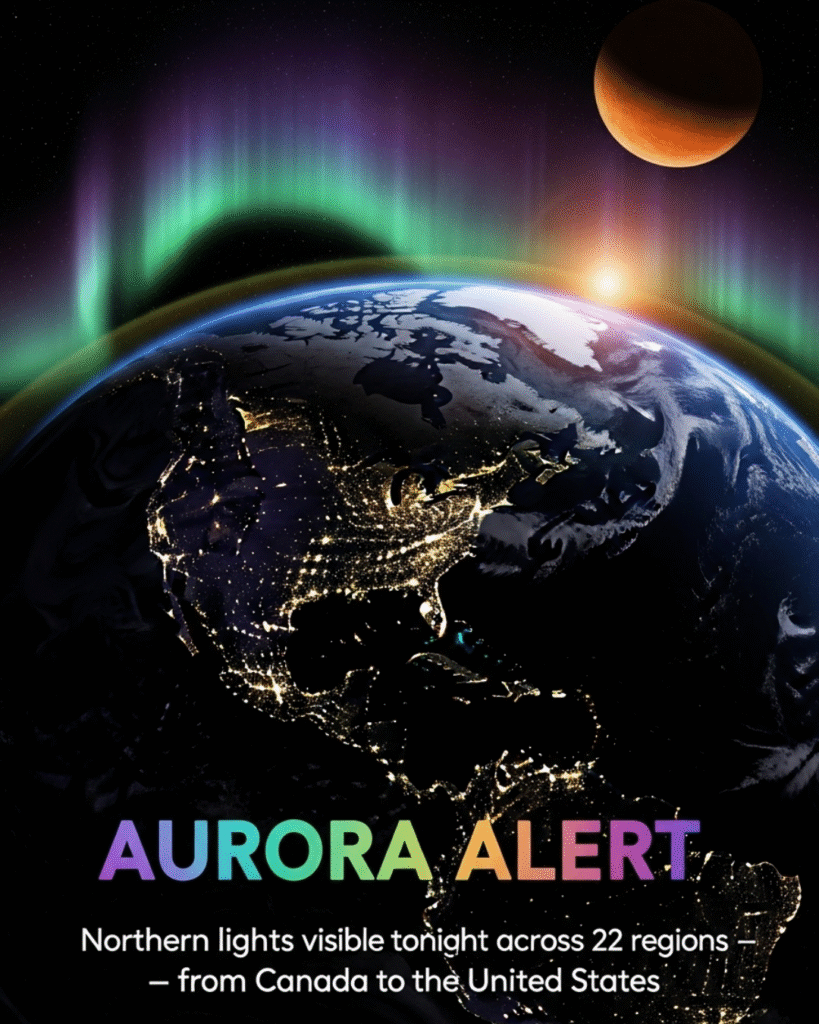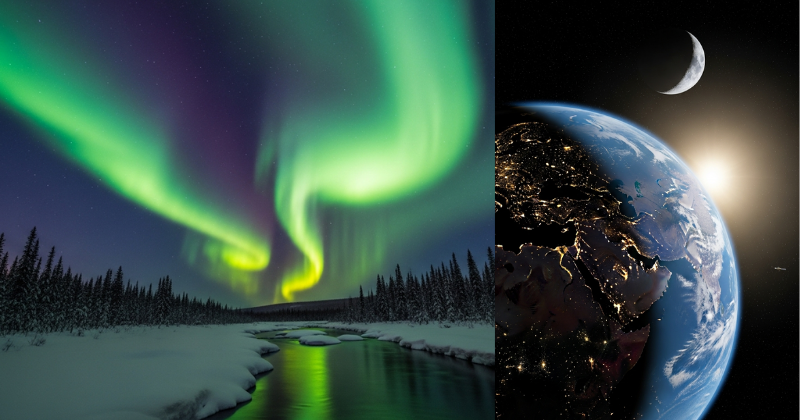A rare and powerful solar event has prompted an extraordinary aurora forecast. The Northern Lights, or Aurora Borealis, are anticipated to be visible across a remarkable 22 regions, extending the viewing area far beyond the typical high-latitude “auroral oval” deep into the contiguous United States and southern Canada. This article dissects the precise space weather conditions, the scientific mechanisms driving this widespread visibility, and the key factors necessary to witness this geophysical spectacle tonight.

🌌 What is Driving the Exceptional Aurora Visibility Tonight?
The extensive visibility of the Northern Lights tonight—stretching across latitudes rarely illuminated by the phenomenon—is attributable to a significant disturbance in Earth’s magnetosphere, known as a Geomagnetic Storm. This specific event has been triggered by a powerful surge of plasma and magnetic fields emanating from the Sun.
This energetic input originates from a recent Coronal Mass Ejection (CME) and, potentially, an accompanying High-Speed Solar Wind (HSSW) stream originating from a coronal hole. A CME represents a massive expulsion of solar material into space, often traveling at speeds exceeding 1,000 kilometers per second. When the magnetic structure of this cloud aligns antagonistically with Earth’s magnetic field—specifically, when the Interplanetary Magnetic Field (IMF) component, known as the $B_z$ vector, points southward—it facilitates an efficient coupling, allowing solar wind energy to pour into the magnetosphere. The resultant geomagnetic storm conditions are expected to be sufficiently strong (potentially reaching G3, or “Strong,” on the NOAA Space Weather Scale) to drastically expand the auroral oval equatorward, bringing the phenomenon into view for observer across 22 regions from Canada to the United States.
🔬 How Does the Geomagnetic Storm Propel the Aurora Southward?
The mechanism that makes the Northern Lights visible across such a vast geographic area is directly linked to the intensity and energy transfer during a geomagnetic storm. Normally, Earth’s magnetic field acts as a shield, deflecting the majority of charged solar particles.
When the IMF’s $B_z$ component turns strongly negative (southward), it causes a temporary magnetic reconnection on Earth’s dayside. This process effectively opens a conduit, allowing a massive influx of charged solar particles to bypass the magnetic shield and enter the magnetosphere’s tail. As this energy builds, the magnetosphere becomes highly stressed. The subsequent release of this stored energy drives a cascade of particles down the magnetic field lines toward the polar regions.
Crucially, the sheer volume and speed of these particles during a strong storm cause the auroral oval—the region where the aurora is most active—to temporarily inflate and expand dramatically towards the equator. This expansion is quantifiable using the Planetary K-index ($K_p$), which measures the disturbance in the Earth’s magnetic field. A typical $K_p$ value of 2-3 keeps the aurora near Alaska and Northern Canada. For visibility spanning 22 US states and Southern Canada, the storm is predicted to push the $K_p$ index to levels of 6 or 7, which correlates directly with the visual expansion seen in auroral modeling systems like the OVATION model.
📊 Which Geomagnetic Indices Predict Widespread Visibility?
The two primary metrics used by space weather forecasters, such as NOAA’s Space Weather Prediction Center (SWPC), to predict and quantify the visibility of the Northern Lights are the Planetary K-index ($K_p$) and the NOAA G-Scale.
H3: The Planetary K-index ($K_p$)
The $K_p$ index is a global scale ranging from 0 (very quiet) to 9 (extreme storm). It is a three-hour average of geomagnetic activity measured by magnetometers worldwide. The general correlation between $K_p$ and the equatorward extent of the auroral oval is a cornerstone of aurora forecasting:
| Kp Level | NOAA G-Scale | Equatorward Magnetic Latitude | Typical Geographic Visibility |
| 0 – 4 | Quiet – Active | $60^{\circ}$ and above | Alaska, Northern Canada, Iceland |
| 5 (G1) | Minor Storm | $\approx 56^{\circ}$ | Northern Tier US states, Southern Canada |
| 6 (G2) | Moderate Storm | $\approx 54^{\circ}$ | Mid-tier US states (e.g., Michigan, Maine, Washington) |
| 7 (G3) | Strong Storm | $\approx 52^{\circ}$ | Extended visibility reaching as far south as Pennsylvania, Illinois, and Oregon |
The current event is anticipated to reach a $K_p$ of 6 or 7 (G2-G3), which is the threshold required to extend the auroral visibility far enough south to encompass the projected 22 regions from Canada to the United States.
H3: The Interplanetary Magnetic Field ($B_z$)
While the $K_p$ index is a measure of the result of the solar interaction, the most critical predictor of an imminent, strong aurora is the $B_z$ component of the IMF. Satellites positioned at the L1 Lagrangian point, such as NOAA’s DSCOVR satellite, monitor the solar wind parameters approximately one hour before they reach Earth. A strong, prolonged negative (southward) reading in the $B_z$ component confirms the magnetic alignment necessary for efficient energy transfer and is the signal that a widespread aurora event is highly probable.
🔭 What Are the Physical Mechanisms Behind the Aurora’s Colors?
The stunning colors of the Northern Lights—which tonight could range from the common green to rarer reds and purples—are dictated by the specific atmospheric gases the charged solar particles collide with and the altitude at which those collisions occur.
- Green: The most frequent and brightest aurora color is produced by the collision of electrons with Oxygen atoms at lower altitudes (around 100 to 300 km). This is the primary color observed during moderate storms.
- Red: High-altitude Oxygen atoms, above 300 km, produce the deep, rich red hues. These reds are typically only visible during powerful geomagnetic storms (like the G3 event expected tonight) because they require higher energy input to excite the oxygen at such lofty levels. This red fringe is often what allows the aurora to be seen from the more southern regions included in tonight’s alert.
- Blue/Purple: Nitrogen molecules are responsible for the blue and purplish-red colors. These tend to appear at the lower edges of the auroral curtain. The complexity of the color palette observed tonight will be a direct indicator of the intensity of the solar energy deposition into Earth’s upper atmosphere.
⏱️ When is the Optimal Time for Viewing the Aurora Tonight?
While the geomagnetic storm may persist for several hours, the most dynamic and intense phase of the aurora is typically observed during the hours surrounding local midnight—specifically between 10:00 PM and 2:00 AM local time.
Auroral activity is driven by auroral substorms, which are short, powerful bursts of activity in the magnetotail. These substorms, lasting 10 to 30 minutes, often produce the brightest and most rapidly moving features, making them the most visually compelling period of the display. To maximize the chance of witnessing this event across the 22 regions, observers must seek out the darkest skies during this peak window.
🗺️ What Geographic Zones are Encompassed by the 22-Region Alert?
The G3-level geomagnetic storm expected tonight pushes the equatorward boundary of potential visibility dramatically southward. The 22 regions primarily encompass:
- Canada: Provinces including British Columbia, Alberta, Saskatchewan, Manitoba, Ontario, and Quebec (especially the northern and central portions).
- United States: A wide swath of northern and mid-latitude states, typically including Alaska, Washington, Oregon, Idaho, Montana, North Dakota, South Dakota, Minnesota, Wisconsin, Michigan, New York, and the New England states. During a strong G3 event, visibility may extend as far south as Iowa, Illinois, Ohio, and even into parts of Nebraska and Pennsylvania.
It is crucial to note that for observers in the southern regions of the alert, the aurora will likely appear as a low, faint glow on the northern horizon, contrasting sharply with the dynamic overhead displays experienced in the high-latitude zones within the core auroral oval.
☁️ Which Terrestrial Factors Influence Aurora Viewing Success?
Even with ideal space weather conditions—a strong geomagnetic storm and negative $B_z$—visibility is fundamentally dependent on terrestrial atmospheric factors.
- Light Pollution: Artificial lighting from urban centers is the single greatest inhibitor of faint aurora displays. To successfully observe the Northern Lights, particularly at mid-latitudes, observers must travel far from city lights to a location with a low level of sky brightness.
- Cloud Cover: Clear skies are non-negotiable. Even a thin layer of high cloud cover can completely obscure the aurora. Consult local weather forecasts to ensure low cloud coverage, particularly facing the northern horizon.
- Moon Phase: While the aurora is strong enough to be seen even during a full moon, a new moon phase or a low moon maximizes the contrast, allowing the subtle greens and reds to be seen more easily, enhancing the experience for observers across the 22 regions.
🚀 Why are These Extreme Auroral Events Occurring Now?
The current phase of heightened auroral activity, resulting in widespread alerts such as the one extending across 22 regions from Canada to the United States, is fundamentally linked to the Sun’s predictable 11-year cycle of magnetic activity.
The Sun is currently progressing toward or is near the peak of Solar Cycle 25, often referred to as Solar Maximum. During this period, the Sun’s magnetic field is at its most complex, leading to an increase in sunspots, solar flares, and the powerful Coronal Mass Ejections responsible for major geomagnetic storms. While the long-term cycle dictates the frequency of these events, the precise timing of tonight’s storm is the result of the specific, Earth-directed trajectory of the recent solar eruption, perfectly aligning the conditions for this spectacular, low-latitude visibility.
Conclusion
The Northern Lights visible tonight across the vast expanse of 22 regions from Canada to the United States represent a confluence of optimal, high-energy space weather conditions driven by a significant geomagnetic storm. The predicted high $K_p$ values indicate the necessary expansion of the auroral oval, offering a rare opportunity for mid-latitude observers to witness the collision of solar particles with Earth’s atmosphere. Successful viewing is contingent upon overcoming terrestrial factors like light pollution and cloud cover, but the scientific evidence confirms the strong potential for a visually impactful display. The current state of Solar Cycle 25 suggests that while this is an exceptional alert, we are likely to see continued strong auroral activity in the near future.
